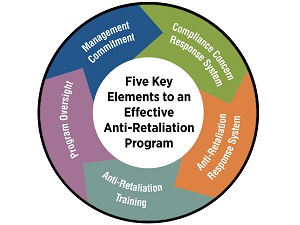A successful anti-retaliation program improves employee engagement and helps protect employers and workers from violations of federal laws and regulations.

Retaliation against employees who raise or report workplace health and safety concerns is not only illegal, it is also bad for workers and bad for business. A proactive anti-retaliation program is designed to:
- receive and respond appropriately to employees’ compliance concerns (like concerns about safety hazards)
- prevent and address retaliation against employees who raise or report concerns.
Without an effective program, problems in the workplace may go unreported because workers fear retaliation for reporting hazards or feel frustration over the lack of effective resolution of their concerns.

If a worker believes working conditions are unsafe or unhealthful, OSHA recommends that they bring the conditions to the employer’s attention, if possible. This provides the employer the opportunity to be made aware of the situation and provide corrective and preventative action.
OSHA’s Whistleblower Protection Program enforces more than 20 federal laws that protect employees from employer retaliation after raising or reporting concerns about workplace hazards or violations. Employees who believe that they have experienced retaliation at work after they have raised a concern may file a complaint with OSHA.
Organizations with successful anti-retaliation programs can avoid unnecessary reports filed with OSHA while protecting the rights of workers and saving time and money for the company.
An anti-retaliation program that enables all members of the workforce, including permanent employees, contractors, and temporary workers, to voice their concerns without fear of retaliation can help employers learn of problems and appropriately address them before they become more difficult to correct.
A program based on this proactive approach not only helps employers ensure that they are following federal laws, but also helps create a positive workplace culture that prevents unlawful retaliation against employees. A successful anti-retaliation program also improves employee satisfaction and engagement.

It’s important that employers understand what retaliation means and why they can be liable if actions are taken against an employee after they raise a health and safety issue to management.
Retaliation occurs when an employer (typically through a manager, supervisor, or administrator) takes an adverse action against an employee specifically because the worker reported, or attempted to report, a concern about a workplace condition or activity that could have a negative impact on the safety, health, or well-being of employees or the public. Retaliation also occurs when an employer takes an adverse action because an employee reported an injury or to dissuade an employee from reporting an injury.
Retaliation can include adverse actions against the employee like:
- Firing or laying off
- Blacklisting
- Demoting
- Denying overtime or promotion
- Disciplining
- Denying benefits
- Failing to hire or rehire
- Intimidation or harassment
- Making threats
- Reassignment affecting promotion prospects
- Reducing pay or hours
- Isolating, ostracizing, or mocking
- False accusations of poor performance
- Reporting, or threatening to report, to the police or immigration authorities

Implementing an effective anti-retaliation program is not intuitive and requires specific policies and commitments. There are five key elements to creating an effective anti-retaliation program:
- Management leadership, commitment, and accountability
- System for listening to and resolving employees’ safety and compliance concerns
- System for receiving and responding to reports of retaliation
- Anti-retaliation training for employees and managers
- Program oversight
In order to effectively support employee reporting and protect employees from retaliation, employers should integrate all five elements into a cohesive program.
Managers at all levels should be held accountable for the quality of their response to employees’ concerns, including reports of potential violations of the law, of safety hazards, and of retaliation.
Create at least one or, preferably, multiple channels for reporting compliance concerns and take all reports of retaliation seriously.
Effective training is key to any anti-retaliation program and a well-designed program needs rigorous oversight to ensure that it is effective and working as intended.
To learn more about the five key elements to creating an effective anti-retaliation program for your organization, download OSHA’s in-depth guide on Recommended Practices for Anti-Retaliation Programs.

.jpg)

.jpeg)